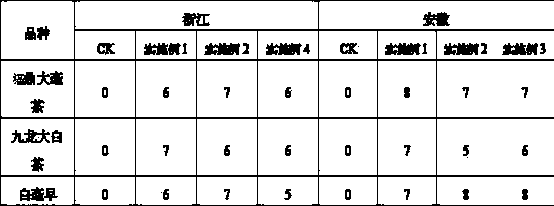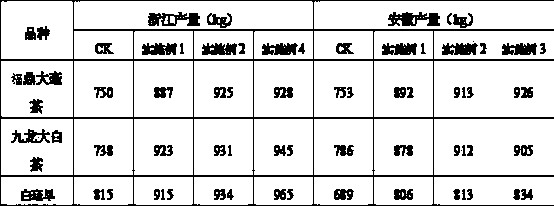Method for producing tea foliage fertilizer by using sisal hemp wastewater
A technology of sisal wastewater and foliar fertilizer, which is applied in the directions of sewage/sludge fertilizer, organic fertilizer, fertilization device, etc., can solve the problems of pollution and low production cost, and achieves the solution of environmental pollution problem, low production cost and effective improvement. The effect of utilization
- Summary
- Abstract
- Description
- Claims
- Application Information
AI Technical Summary
Problems solved by technology
Method used
Image
Examples
Embodiment 1
[0035] Raw material formula ratio: 750 kg of fresh sisal wastewater, 50 kg of trace elements (Cu is provided by copper sulfate; Fe is provided by ferrous sulfate; Zn is provided by zinc sulfate containing crystal water; B is provided by sodium tetraborate; Mn is provided by manganese sulfate Provide), organic acid, 30 kg (citric acid + oxalic acid + acetic acid + malic acid), pest repellent 10 kg, hand washing fruit soaking solution 1 kg.
[0036] The production method of tea foliage fertilizer: take fresh sisal waste water, organic acid, trace elements, pest repellent and surfactant according to the above formula, stir and mix them evenly and put them into a closed fermenter for fermentation. The fermentation temperature is 30-50°C, the fermentation time is 10 days, and then the fermented mixture is filtered, and the filtrate is collected to obtain fruit foliage fertilizer.
Embodiment 2
[0038] Raw material formula ratio: 800 kg of fresh sisal wastewater, 60 kg of trace elements (Cu is provided by copper sulfate; Fe is provided by ferrous sulfate; Zn is provided by zinc sulfate containing crystal water; B is provided by sodium tetraborate; Mn is provided by manganese sulfate Provided), 40 kg of organic acid (citric acid + oxalic acid + malic acid), 12 kg of pest repellent, 2 kg of soaking solution of hand washing fruit.
[0039] The production method of tea foliage fertilizer: take fresh sisal waste water, organic acid, trace elements, pest repellent and surfactant according to the above formula, stir and mix them evenly and put them into a closed fermenter for fermentation. The fermentation temperature is 30-50°C, the fermentation time is 15 days, and then the fermented mixture is filtered, and the filtrate is collected to obtain the fruit foliar fertilizer.
Embodiment 3
[0041] Raw material formula ratio: 820 kg of fresh sisal wastewater, 80 kg of trace elements (Cu is provided by copper sulfate; Fe is provided by ferrous sulfate; Zn is provided by zinc sulfate containing crystal water; B is provided by sodium tetraborate; Mn is provided by manganese sulfate provided), 50 kg of organic acid (citric acid), 15 kg of pest repellent, 4 kg of soaking solution of hand washing fruit.
[0042] The production method of tea foliage fertilizer: take fresh sisal waste water, organic acid, trace elements, pest repellent and surfactant according to the above formula, stir and mix them evenly and put them into a closed fermenter for fermentation. The fermentation temperature is 30-50°C, the fermentation time is 12 days, and then the fermented mixture is filtered, and the filtrate is collected to obtain fruit foliage fertilizer.
PUM
 Login to View More
Login to View More Abstract
Description
Claims
Application Information
 Login to View More
Login to View More - R&D
- Intellectual Property
- Life Sciences
- Materials
- Tech Scout
- Unparalleled Data Quality
- Higher Quality Content
- 60% Fewer Hallucinations
Browse by: Latest US Patents, China's latest patents, Technical Efficacy Thesaurus, Application Domain, Technology Topic, Popular Technical Reports.
© 2025 PatSnap. All rights reserved.Legal|Privacy policy|Modern Slavery Act Transparency Statement|Sitemap|About US| Contact US: help@patsnap.com


